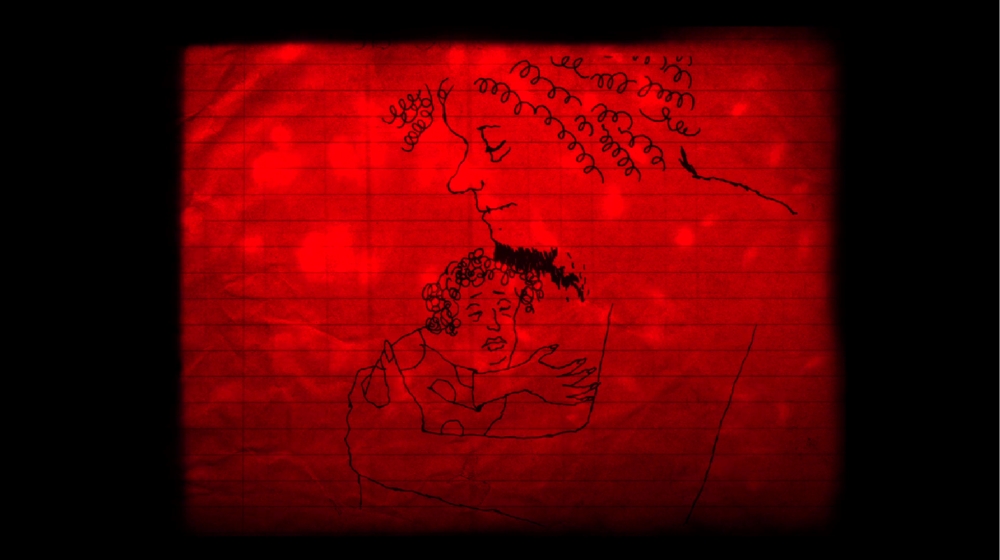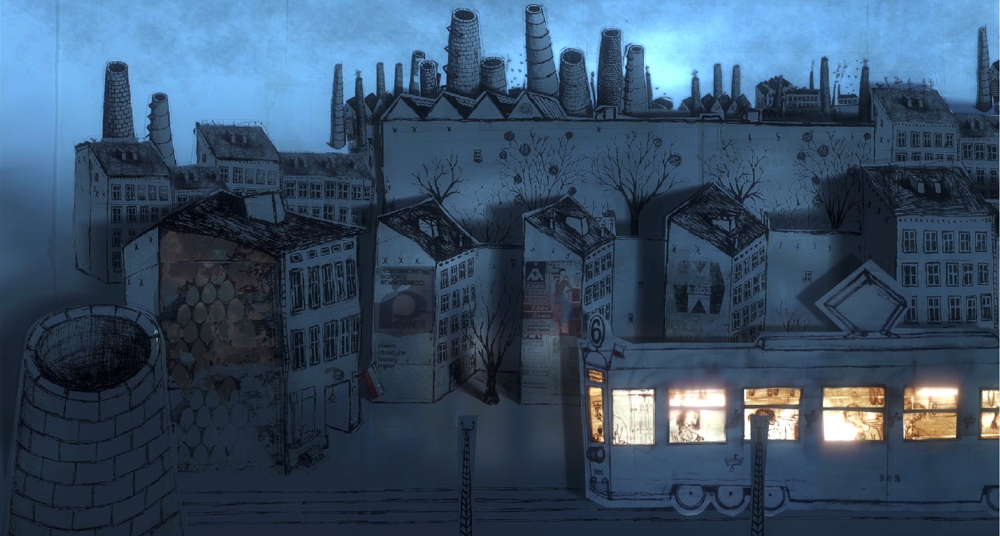***This article originally appeared in the February ’21 issue of Animation Magazine (No. 307)***
More than 14 years ago, self-taught Polish artist, writer and director Mariusz Wilczyński set out to make a deeply personal animated short. As the years went by, that highly original project evolved and grew into a 90-minute tapestry of memories, characters from his favorite literary works and a deeply moving meditation about honoring and living with the ghosts of the past. Last year, some fortunate festival-goers were finally able to see this labor of love, a project that was described by Indiewire as “a movie so lo-fi it makes Don Hertzfeldt look like Walt Disney!”
Wilczyński, who has been creating highly creative animated shorts since the mid-’90s, been the subject of retrospectives at various museums and shown his work at the National Gallery in London and the Berlinale, says his project became more ambitious after he decided to have the role of an old train passenger be voiced by actress Irena Kwiatkowska, who was a childhood hero of his. Her dramatic reading made him realize what a huge difference a talented actor can make in an animated feature. “Her acting made me realize what great impact an actor can have with all the mastery that she brought to my film,” he says. “I then created other characters, voiced by Andrzej Wajda and Gustaw Holoubek, and these characters also began to inspire me to create their identity and behavior in the film. I had their appearance, their words, I knew their manner of speaking, which helped me draw the characters precisely.”
Another huge catalyst was a 2017 retrospective of his work at the Mill Valley Film Festival. “During that time I was invited to visit Pixar Studio,” he recalls. “They were just finishing Coco and I was given a tour by the great animator Doug Frankel. He took me to places that they don’t usually show visitors. That’s how I found out that they first come up with the characters and their lines of dialog, and then an animator records those lines, the lip-synched version is drawn and finally the star adds their voice to the project. So I decided to also use great Polish actors to create the world of my imagination, sensitivity and values … My goal was to surround myself with these people because I learned my values from them.”

Loss Inspires Art
According to the artist, his parent’s deaths about 20 years ago shook him quite heavily and inspired him to bring his experiences and emotions to animated life. “They separated when I was three years old, but they both died within a very short time,” he tells us. “My mother was the first to go. I felt very guilty for neglecting them, for being abrasive towards them, for not expressing love, especially towards my mom. I never told her that I loved her. At the time when they were both old and they needed assistance, when they were in the hospital, I never had time for them. I was busy doing everyday tasks, making my films and indulging in my hobbies. I was constantly telling myself, ‘I’ll call my mom later,’ or ‘I’ll visit her soon, but I have so much to do right now.’”
It is quite painful for Wilczyński to look back at that time in his life. “You only need to do so little to bring joy to an elderly person — just a visit or a talk,” he admits. “But I couldn’t afford to do it — I was a self-centered egoist. I was always putting off visiting them or making a phone call. I would always say, ‘Tomorrow’ … and at some point, there were no more ‘tomorrows.’ I felt devastated and remorseful for not hugging my parents before they died, for not telling them that I loved them. I had deserted them.”

A special retrospective at MoMA gave him the encouragement to use his parents as a starting point for the movie. “I had to summon up the courage and reflect upon a part of my life and reconcile,” he notes. “I knew that I could build my ‘magic box,’ bring them back to life and make up for my mistakes. Then, a year into making the film, I lost my closest friend and the most important man in my life, Tadeusz Nalepa, whose music is the soundtrack of the film. He joined the land of ghosts in my film. The film was made for my mom, who supported me so much, but also for Tadeusz, who was my great friend. I am very pleased that I was able to use Tadeusz’s music in the movie since he didn’t get any airplay in Poland during his life, but is now acknowledged for his art. The point of making the film was to meet my mom, my dad and Tadeusz again, to have an honest conversation and tell them all that I love them.”
Reflecting on his childhood, Wilczyński, says he always loved drawing as a young boy. A favorite subject were Polish knights fighting with Teutonic Order cavaliers. “I actually got my first ‘Fs’ in school for my drawings,” he admits. “When I was seven, I used to spend holidays in the countryside with my mother, and I noticed that the male horses had big willies. So, when I drew the most famous knight, Zawisza Czarny, on top of a horse, I included a huge wiener. My mom was called to school because of that and I was pretty close to getting expelled. Luckily, she managed to talk the principal out of it.”

Finding a New World
Nevertheless, Wilczyński kept drawing and he ended up studying painting at the Academy of Fine Arts in Łódź under the great painter Stanisław Fijałkowski. After graduation, he embarked on his own promising painting career. He drew many pictures for a celebration of the acclaimed poet and diplomat Czeslaw Milosz’s collection Road-side Dog for Polish television. “After I saw my drawings featured in the program, I went crazy,” he says. “I decided to leave my painting career, cross out everything that had happened before, and make the pictures come alive. I didn’t know how to do it, but I made one crucial decision: I would never look at what other animators are doing or read books to learn the technology. My goal was to experience it on my own, in my own way. At 35, I was beginning a new adventure — and like a child, I was discovering the world from the very basics. I felt like Columbus and had no idea where I would sail to!”
The artist decided to do all the backgrounds for Kill It and Leave This Town by hand. “The process of creating the environments was a bit like that of the film: I added up more and more elements of the story to finally get an hour and a half. The drawings emerged in a similar way — I drew a picture on a scrap of paper, but I lacked some space, so I glued it together with another piece of paper. Then, I felt like there wasn’t enough space, so I attached another picture, and that’s how it began to grow. You can see all these joints between pieces of paper in the film. I wanted to expose this, because it’s a very organic and natural matter of paper, of surface, and some creasing. Some pictures behaved in the same way — as the film was in the making for a dozen years, some of the first drawings started to look more pale, the ink changed in shade, and everything started living its own life.”

Wilczyński believed it was very important to keep the natural patina of the artwork throughout the movie. “I refused to clean it,” he says. “I wasn’t initially certain if I should leave it or not, but when I saw how it works together with the film and how it all lives organically, I loved that. We used all the effects manually. These were the neons, the lights, the lamps. Everything was photographed with a camera. We constructed these small neons by hand and so on. Raindrops, fog, city lights were manually put into the hand-drawn backgrounds. In the post-production stage, we used the most modern technologies and worked together with some young brilliant digital animation artists who assembled it all together.”
Most of the film’s sounds were also recorded manually. “We no longer have those old streetcars in Łódź, so we recorded the sound in Lisbon and in Prague,” explains the director. “The sounds of the trains were recorded in Vietnam, as those natural sounds are nowhere to be found in Poland anymore.”
The Personal Is Universal
The helmer is quite pleased that this hugely personal work has been getting positive reviews at festivals around the world. “It is very rewarding to hear other people saying that they will change their attitude toward their loved ones after watching the film,” he says. “But frankly speaking, I had no expectations from audiences whatsoever. I made the film for myself, my parents and my friend. I didn’t think that I was making a film that could help someone, that might give them something. I was a bit fearful that the film would not be understood outside of Poland, but also, I hoped that the audience would like it.”

He says he also thought that the movie would only appeal to those over 35, but after a screening of the movie in Lima, Peru, three young people told him that they were deeply affected by it. “They told me, ‘What are you even saying? Here in Peru, we’ve had a lockdown for three months. Every one of us has lost a loved one to COVID. Don’t say the film is for an older audience because we’re in our 20s and we can perfectly understand it.’ It might be that this film, especially at this time, has an additional impact.”
The director also was quite touched when a young film critic in Poland praised his movie and wrote, “For the first time I am afraid I might lose someone very close to me — my grandparents. There’s a pandemic, I am worried about them, so I call every day to check if they’re okay. Kill It and Leave This Town is an antidote to my anxiety and fear.” Wilczyński concludes, “I might have expected that the film would be understood in Poland, but I never thought that it would be readable outside of my country. These dozens of reviews and the awards we received came as a surprise to me. What was the most surprising and important is the reception of the film. Even though it’s an art film, a kind of tale based on my emotions, not a documentary or a typical feature, it can still resonate with people and make them a little bit better. I find it incredible that some elderly people’s lives might also become brighter thanks to it.”
Kill It and Leave This Town won a Jury Distinction at Annecy and Best Animated Feature at Ottawa in 2020. The film will screen as part of the Vidiots Foundation Virtual Screening series on Feb. 3 and MoMA’s Contenders screening series Feb. 11-16. The film is distributed by Outsider Pictures and will expand in the first quarter of 2021.




 Win a Funko X Lilo & Stitch Prize Pack!
Win a Funko X Lilo & Stitch Prize Pack! 